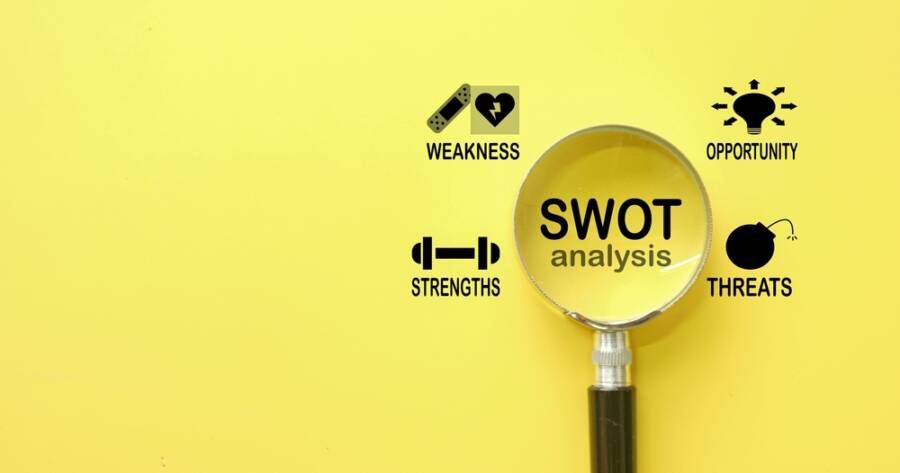Understanding where you stand professionally is the first step toward meaningful growth. A personal SWOT analysis—evaluating your strengths, weaknesses, opportunities, and threats—helps you reflect honestly and strategically about your career path. It allows you to pinpoint what you do well, where you can improve, and what external trends may influence your progress. This structured reflection creates a clearer, more confident approach to setting and pursuing career goals.
What Is a Personal SWOT Analysis?
SWOT stands for Strengths, Weaknesses, Opportunities, and Threats. It’s a structured framework that companies use to evaluate where they stand in the market. But it’s also incredibly useful for individuals who want to better understand their current career position and plan their next move.
A personal SWOT analysis helps you reflect on what you do well, where you need to improve, what external opportunities you could take advantage of, and what challenges may hold you back. When you write everything down, it becomes easier to spot patterns, set goals, and make decisions with clarity.
The beauty of SWOT is in its simplicity. With just four categories, you can turn confusion into a clear, personalized strategy.
Identifying Your Strengths and Weaknesses
Start your analysis by focusing inward. Think about your strengths—the things you’re naturally good at or have developed through experience. These could include technical skills, communication abilities, creative thinking, leadership, or reliability. Strengths also include traits that others consistently praise or rely on you for.
Next, be honest about your weaknesses. This isn’t about beating yourself up—it’s about recognizing areas where you could grow. Maybe you struggle with time management, avoid public speaking, or find it hard to say no to extra work. Naming these areas is the first step to improving them.
Here’s a tip: ask a trusted friend, coworker, or mentor for feedback. Sometimes others can see our blind spots better than we can. The goal is to build an accurate picture of what’s helping you succeed and what might be slowing you down.
Exploring Opportunities and Threats
Now shift your focus to external factors. Opportunities are outside events or trends that could benefit your career. These might include industry growth, new skills in demand, networking events, job openings, or online courses. Opportunities can also come from your own interests—maybe you’ve always wanted to start a side project or apply for a new role.
On the other hand, threats are external challenges that could block or delay your progress. These could include economic shifts, industry changes, company layoffs, or personal responsibilities like caregiving. Being aware of threats allows you to prepare for them rather than being caught off guard.
When done together, this full SWOT view helps you take stock of what’s in your control and what’s not—so you can make informed, proactive choices.
Turning Insights into an Action Plan
Once you’ve filled out all four sections of your SWOT analysis, you’re ready to turn your insights into a plan. Start by looking for connections. For example, if your strength is writing and you see an opportunity in content marketing, that could be a clear direction to explore.
If one of your weaknesses is lack of confidence in interviews and a threat is increased competition for jobs, then improving your interview skills becomes a top priority. You can set a short-term goal to practice with a coach, join a speaking group, or record yourself to build confidence.
Using your SWOT results, you can create focused goals that feel both personal and realistic. Instead of vague intentions like “get better at work,” you’ll have specific steps based on what truly matters to you and your career.
Try revisiting your SWOT analysis every few months, especially when you’re considering a job change, asking for a raise, or learning a new skill. Over time, you’ll notice growth and become better at spotting new opportunities before they even arise.
Tools to Help You Stay Focused
While you can do a SWOT analysis on paper, using digital tools can help you track your thoughts and revisit them easily. Apps like Notion, Monday, or Asana allow you to organize your SWOT in one place and update it as you grow.
You can also pair your SWOT with goal-setting frameworks like SMART goals or the 90-day plan. This adds structure and timelines to your insights. Set a reminder to review your progress weekly or monthly so you stay motivated and aware of what’s changing around you.
No matter what tool you use, the key is to take action. Your SWOT analysis isn’t just a reflection—it’s a launchpad for career growth.
Your Roadmap to Meaningful Growth
Doing a personal SWOT analysis may seem simple, but the insights it offers are deep. It helps you understand yourself in a way that leads to better choices, stronger strategies, and more confidence in your path. Whether you’re early in your career or planning your next big leap, this framework puts you in the driver’s seat.
With honest reflection and a willingness to act, you can move from where you are to where you want to be—step by step, with a clear sense of direction. Your career is a journey, and SWOT is a map that can guide you through it.

